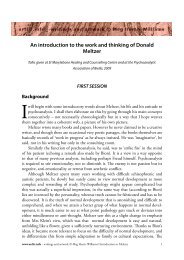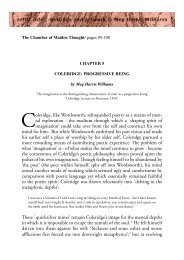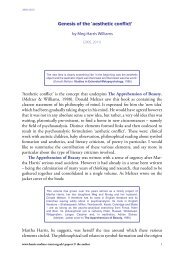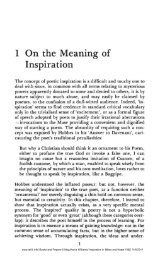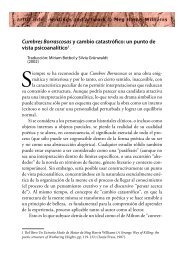Moving Beauty: A Review - Hampshire Art and Crafts Magazine - Artlit
Moving Beauty: A Review - Hampshire Art and Crafts Magazine - Artlit
Moving Beauty: A Review - Hampshire Art and Crafts Magazine - Artlit
Create successful ePaper yourself
Turn your PDF publications into a flip-book with our unique Google optimized e-Paper software.
<strong>Moving</strong> <strong>Beauty</strong>: A <strong>Review</strong> - <strong>Hampshire</strong> <strong>Art</strong> <strong>and</strong> <strong>Crafts</strong> <strong>Magazine</strong><br />
The ideas in this chapter are complex <strong>and</strong> we found the text often dense<br />
<strong>and</strong> challenging, both intellectually <strong>and</strong> personally. Harris-Williams<br />
argues from a position of considerable literary, philosophical <strong>and</strong><br />
psychoanalytical knowledge, referring frequently to the thoughts, ideas<br />
<strong>and</strong> writings of her own cultural ancestors <strong>and</strong> internal good objects,<br />
some of whom will be more or less well known to or read by her<br />
readers. Yet it is precisely the scope of her creative attempt to explore<br />
<strong>and</strong> develop these ideas, which must encourage the reader to<br />
persevere, in spite of sometimes stumbling when trying to underst<strong>and</strong>.<br />
STAY INFORMED<br />
Entries (RSS)<br />
Comments RSS)<br />
WHO WRITES<br />
admin<br />
By chance, as we were considering the possibility of reviewing this<br />
chapter, we heard a radio programme, entitled Inside the Life Drawing<br />
Class. During the programme, the presenter Anneka Rice interviewed<br />
both drawers <strong>and</strong> models in a North London class, inviting them to<br />
speak about their experience of life drawing. Although the class<br />
featured neither dance nor music, the participants touched on several of<br />
the themes raised in Harris-William’s chapter. For example, drawers<br />
spoke about their feelings of responsibility towards, <strong>and</strong> empathy for,<br />
the model; the fear of ‘messing up’ or producing a ‘bad’ drawing, one<br />
the model would not like; the fear of making the first mark on their paper, <strong>and</strong> the question whether they could<br />
achieve what they wanted. Others described a sense of privilege in being given permission to look, some seeing<br />
it as an extension of the study of their own bodies or an opportunity to reconnect with their real selves by<br />
responding in a direct <strong>and</strong> creative way to another human body. A model spoke about discovering himself<br />
though the eyes of others. The class was described as an interaction, an ‘unravelling theatre of the moment’<br />
where drawers could be in their own worlds yet connected <strong>and</strong> involved in a ‘voiceless conversation led by the<br />
model’ where what is valid is in the moment.<br />
These thoughts <strong>and</strong> experiences of ordinary drawers in an ordinary class connected considerably in our minds<br />
with the thesis proposed by Harris-Williams <strong>and</strong> encouraged us to put pen to paper to recommend this most<br />
thought-provoking chapter to both psychotherapists <strong>and</strong> those interested in life drawing.<br />
Anne Bloom <strong>and</strong> Wendy Hatto<br />
Glossary<br />
Good object: an object in this context usually refers to a person who is loved by the subject <strong>and</strong> experienced as<br />
benevolent.<br />
Internal good object: this refers to a person who has been experienced by the subject as important <strong>and</strong><br />
benevolent, to the extent that he/she/the experience is ‘taken in’ <strong>and</strong> becomes part of the subject’s mental<br />
structure.<br />
Transference-countertransference: in this context the term refers to the relationship between a therapist <strong>and</strong><br />
patient, or any ordinary two-person relationship, in which one person (the patient) relates to the other (the<br />
therapist) as though he/she were some formerly important object, usually from his/her early life. By contrast, the<br />
countertransference refers to the emotional response of the second person (the therapist) to the behaviour of the<br />
first person (the patient). These are perfectly ordinary interactions which occur in relationships but usually we are<br />
not aware of what is happening at the time.<br />
Analys<strong>and</strong>: a person who is being analysed but is also a student of psychoanalysis.<br />
2 COMMENTS TO “MOVING BEAUTY: A REVIEW”<br />
1. cecilia macagno says:<br />
March 7, 2011 at 6:47 pm<br />
I can’t write englishvery well. I’m an art psycotherapist, I read e <strong>and</strong> appreciate Meg Harris Williams. I<br />
wonder if she Knows anything about Authentic Movement <strong>and</strong> psicodinamic art therapy.<br />
But this is not the right way to ask her about, I suppose.<br />
http://hantsarts.com/wordpress/?p=3259[20/04/2011 17:17:45]




